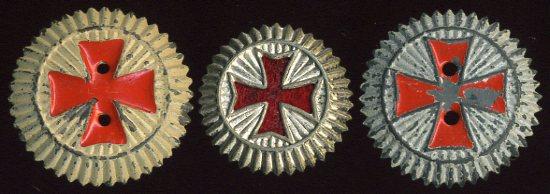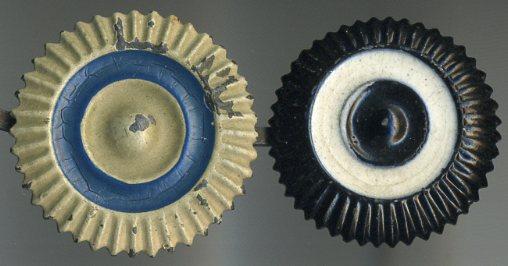-
Posts
2,962 -
Joined
-
Last visited
Content Type
Profiles
Forums
Blogs
Gallery
Events
Store
Everything posted by Chip
-
I believe the two older men are wearing the uniform of the NS-RKB (Nationalsozialistische Reichs-Kriegerbund) or the Marinebund, who had the same insignia, but the navy subsection's insignia was gilt metal with an anchor, which is unclear here. They wore a dark blue suit. It was a veteran's organization. There were ranks within the Bund that were signified by the wearing of an armband on the lower left sleeve. The young sailor in the middle has a cap band that reads "Marineartillerieabteilung" (Naval Artillery Detachment). There was normally a unit number before and after this name, but they cannot be seen in the photo. He is wearing the parade jacket (dress jacket). "MaschOgfr" would have been his rank, Maschinen Obergefreiter (Mechanic NCO), two grades above a basic seaman (Matrose). Chip
-
During the period that this type of unofficial sleeve patch was worn, the shoulder strap number would reflect the pioneer unit that the MWA came from. So, this would not be the 4th Bavarian Schwere Minenwerfer-Abteilung. If there was an Abteilung number at all, it was normally shown on the sleeve patch. Later in 1915, when the new Minenwerfer shoulder strap was introduced, the unit number was displayed on them and the sleeve patches were dropped.
-

SG14 Bayonet
Chip replied to Chris Boonzaier's topic in Germany: Imperial Uniforms, Headwear, Insignia & Personal Equipment
That's nice and newer information than I have. I have an S.14, but am not a bayonet collector per se. -
Hello, Here is a comparison between a Bavarian and Prussian prong backed cap cockade. As anyone can see, they're not even close. Even in a black and white photo like this they are easily differentiated by the location of the white rings. The Bavarian Rautenborte was introduced with their new uniform regulations in 1916 (if anyone needs the exact date, let me know). In the final months of 1917, it was ordered reduced to just a vertical strip on the front edges of the collar. This change was supposed to be in effect for the duration of the war, but in practice, many later war Bavarian tunics never had it applied. Of course, it was worn in the field, but period photos of this are few compared with photos of Bavarians without it.
-

Which regiment?
Chip replied to Mattyboy's topic in Germany: Imperial Uniforms, Headwear, Insignia & Personal Equipment
It's a bit difficult to tell the difference in black and white photos. If you could see them in color, it would be another matter, as Jäger zu Pferde officers had green collars and cuffs, whereas the Kürassier had various regimental facing colors. The braids on those collars and cuffs were very similar and some even overlapped (meaning both a J.z.P. regiment and a Kürassier regiment wore the same braid). The shoulder boards would be another identifying attribute, but they are too far away in these photos to be of any help. Also, the base color of the tunics was different. Jäger zu Pferde wore graugrün and Kürassier wore feldgrau. The second photo shows dark piping on the front edge and the cuffs, so he is from a different unit than the man in first photo. Chip -

German puttees
Chip replied to Tony's topic in Germany: Imperial Uniforms, Headwear, Insignia & Personal Equipment
Hello, Here is the quote from Kraus, "Ein weiterer Entscheid von 14.9.1917 wies darauf hin, daß Wickelgamaschen nur für Fliegerformationen, planmäßige Sturm-Bataillone und Truppen mit Gebirgsausrüstung zugelassen seien." So, it was actually 1917 that this decision was made. He goes on to say that in practice, this directive was largely ignored. Chip -

Another sleeve badge
Chip replied to Tony's topic in Germany: Imperial Uniforms, Headwear, Insignia & Personal Equipment
Feld-Flieger Abt.Nr.66 Chip -

Sleeve insignia 'F'
Chip replied to Tony's topic in Germany: Imperial Uniforms, Headwear, Insignia & Personal Equipment
Eric, Is that your banner? -

Sleeve insignia 'F'
Chip replied to Tony's topic in Germany: Imperial Uniforms, Headwear, Insignia & Personal Equipment
Hi Tony, Normally, within a communications unit, this "F" stands for "Fernsprecher". In this case, if these are members of an artillery unit, it may be an unofficial patch for the same or for a "Feuerwerker" (artificer), thought these were usually NCOs. Chip




